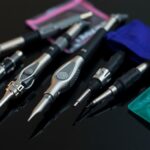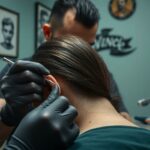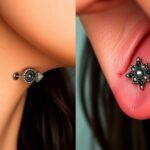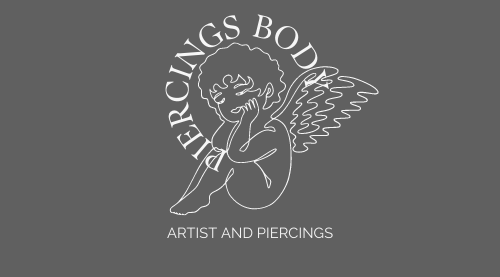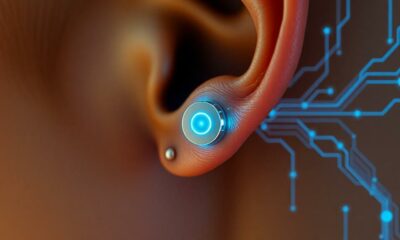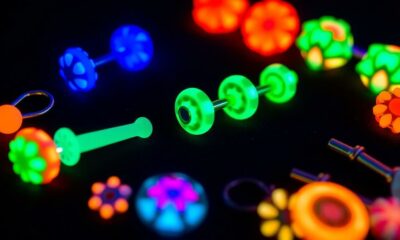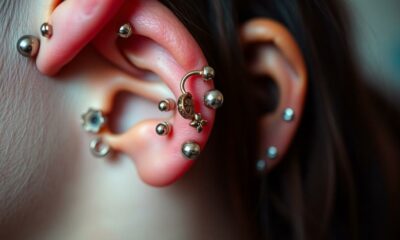Advanced Piercing Techniques
The Art of Freehand Piercing: Pros and Cons
Mastering freehand piercing offers unique benefits and challenges—discover how this technique can impact your experience and what you need to know before diving in.
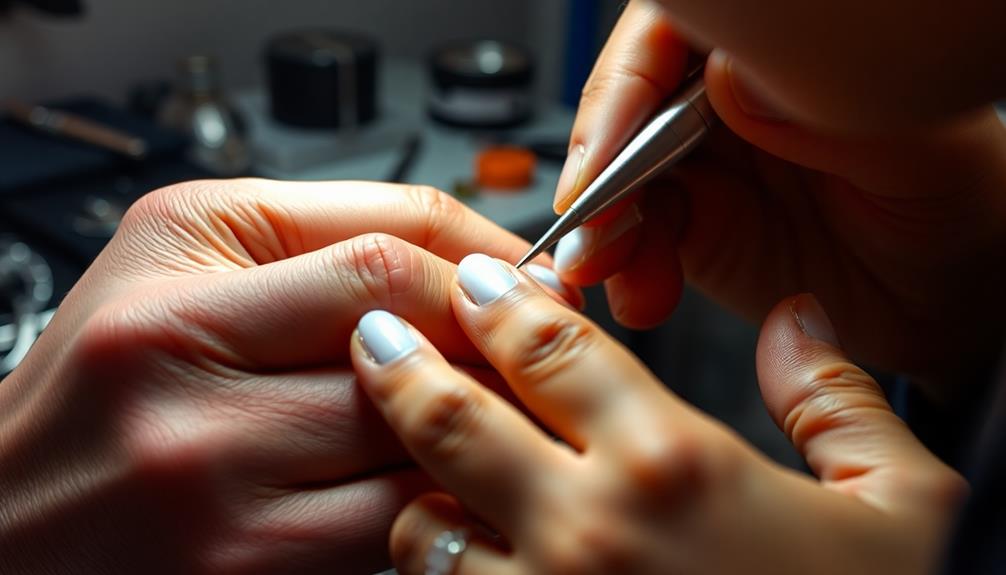
Freehand piercing provides a unique, tailored experience that can enhance both comfort and aesthetics. You'll enjoy minimized tissue trauma, leading to faster healing and a more personalized placement. However, this technique heavily relies on your piercer's skill, which can affect the results. Depth control and limitations in certain areas might pose challenges too. While many appreciate the flexibility and efficiency, the variability in outcomes can be concerning. If you're intrigued by how freehand compares to other techniques and what to expect regarding aftercare, there's plenty more to explore.
Key Takeaways
- Freehand piercing minimizes tissue trauma, promoting faster healing and enhanced comfort compared to traditional methods.
- This technique allows for personalized placements and angle adjustments, catering to individual anatomy and preferences.
- Heavily reliant on the piercer's skill, freehand piercing can lead to variable outcomes and inconsistent results.
- Limited to certain body areas, freehand piercing may not be suitable for all types of piercings.
- Extensive training is required for piercers, which restricts the availability of qualified professionals skilled in this method.
Overview of Freehand Piercing

Freehand piercing is an innovative technique that eliminates the need for clamps or guides, allowing skilled piercers to rely on their precision and expertise. This method has gained traction, particularly among professional piercers keen on minimalistic piercing methods.
By forgoing traditional tools, they can achieve more natural and aesthetically pleasing piercing placements, adapting angles and depths to fit the client's anatomy.
One of the key advantages of freehand piercings is the enhanced comfort it provides. Since this technique often involves less tissue trauma, clients may experience less pain and quicker healing times compared to conventional methods that use clamps.
However, mastering freehand piercing requires extensive training and experience, as it demands a steady hand and a deep understanding of anatomy.
While it offers flexibility and artistic freedom, it's vital to note that this technique mightn't be suitable for all body areas or piercing types. The lack of a guide can limit control over depth, which is significant for specific piercings.
Ultimately, freehand piercing represents a blend of artistry and expertise, appealing to those looking for a more personalized piercing experience.
Advantages of Freehand Piercing
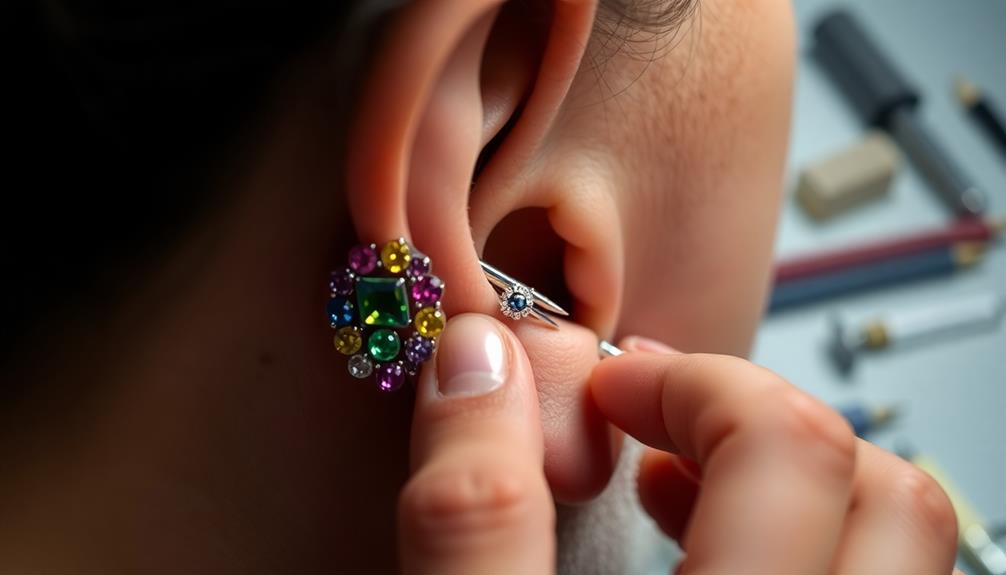
One of the standout benefits of this piercing method is how it minimizes trauma to the tissue. Unlike traditional techniques that use clamps, freehand piercing allows the professional piercer to work directly with your skin, avoiding unnecessary pressure and reducing damage to the skin. This gentler approach often results in faster healing times, as many clients report experiencing less tissue damage.
Another significant advantage is the flexibility in placement and angle that freehand techniques offer. This means your piercing can be tailored to your unique anatomy and preferences, providing a truly customized experience. With the ability to adapt during the procedure, a professional piercer can achieve a more precise and aesthetically pleasing result.
Additionally, freehand piercing promotes a simpler setup since it requires less equipment, which can enhance the overall efficiency of the procedure. The increased precision in placement not only improves healing but also yields a more visually appealing outcome, ensuring you're satisfied with your new piercing.
Disadvantages of Freehand Piercing
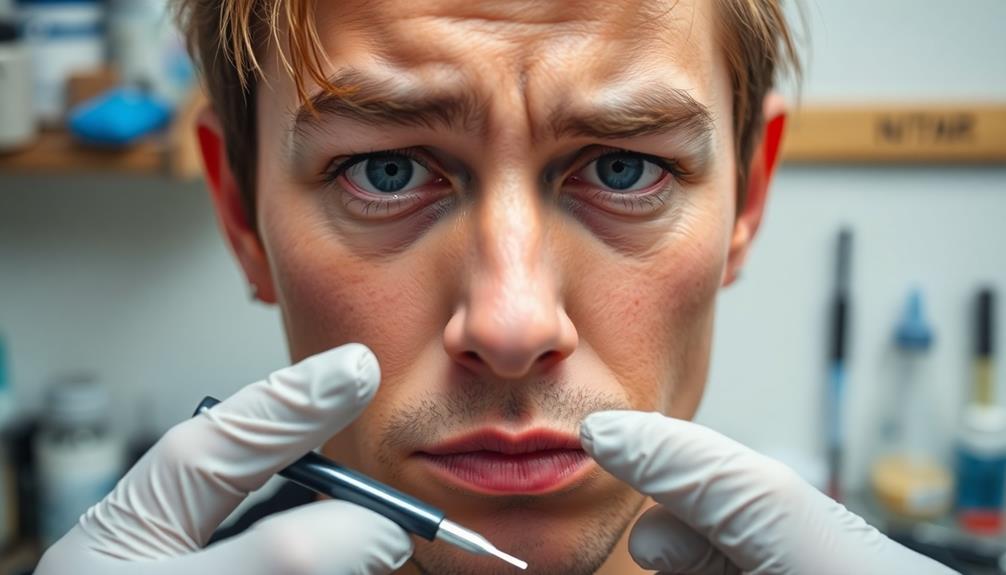
While freehand piercing offers many benefits, it also comes with notable drawbacks that should be considered. One major disadvantage is that this technique relies heavily on the piercer's skill and steadiness. If the technique isn't executed correctly, complications can arise.
Additionally, freehand piercing may not be suitable for all body areas or types of piercings, as some locations require more precision than what freehand methods provide. Without the use of clamps or guides, you have limited control over the depth of the piercing, which can lead to inconsistent results.
This lack of control can affect the overall quality of the body art, impacting both aesthetics and healing. Additionally, mastering freehand piercing demands extensive training and experience, which can limit the number of qualified professionals available to you.
The increased reliance on the piercer's ability means that outcomes can vary considerably from one professional to another. This inconsistency can affect your satisfaction and safety, especially if you're trusting someone with your body.
Consequently, it's crucial to weigh these pros and cons carefully before opting for freehand piercing.
Aftercare Recommendations
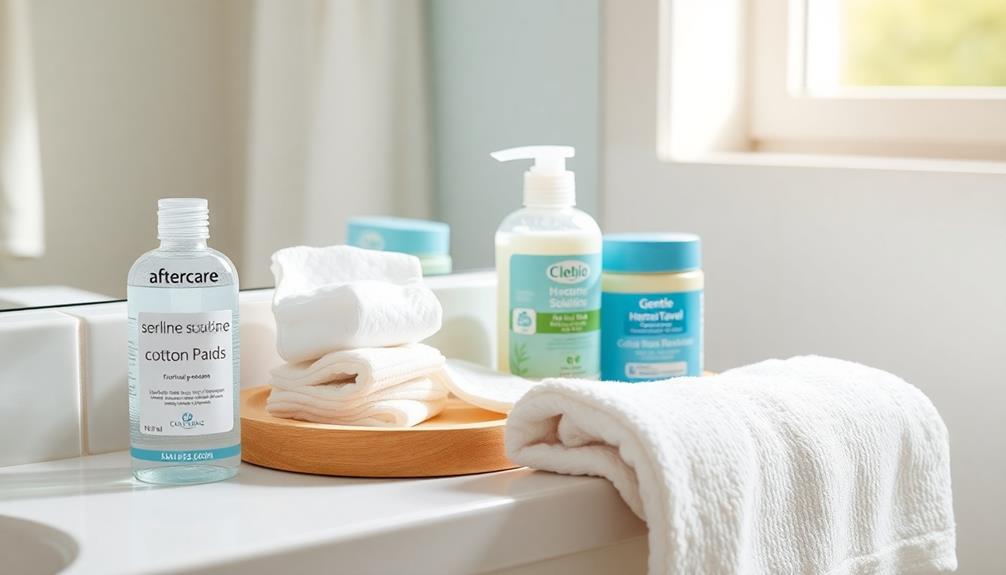
After getting a freehand piercing, proper aftercare is essential for a smooth healing process.
You'll want to use sterile saline solutions for cleaning and avoid alcohol-based products that can irritate the area.
Keep an eye out for any signs of infection, as catching issues early can make all the difference.
Essential Aftercare Products
When you get a freehand piercing, using the right aftercare products is imperative to promote healing and prevent infections. Start with a sterile saline solution, like NeilMed Neil Cleanse Wound Wash. This product helps maintain moisture and aids in the cleanliness of your piercing, ensuring a smoother healing process.
It's essential to avoid alcohol-based solutions, as they can irritate the area and hinder recovery.
If you've had an oral piercing, consider using Biotene Fresh Mint Mouthwash. It keeps your mouth clean without causing irritation, which is crucial for oral piercing aftercare. Always prioritize alcohol-free products to protect your healing tissue.
Regular follow-up care is equally important. Consult with your professional piercer to address any concerns and get tailored advice. They can guide you on using these aftercare products correctly and help you navigate the healing journey.
Cleaning Techniques and Frequency
To guarantee your freehand piercing heals properly, cleaning it at least twice daily is vital. Use sterile saline solutions, like NeilMed Neil Cleanse Wound Wash, as your primary cleaning technique. This helps maintain cleanliness and promotes efficient healing.
Apply the solution gently, making sure you're not using any alcohol-based products, which can irritate the piercing and slow down the healing process.
After applying the saline, use non-woven gauze to dab the area gently, removing any excess moisture. This step is essential for infection prevention, as it keeps the site free from bacteria and debris.
Remember to be consistent with your cleaning routine, as doing it regularly greatly reduces the risk of complications.
In addition to your daily cleaning, consider scheduling follow-up care with your professional piercer. They can provide personalized advice and address any concerns you may have during the healing period.
Staying diligent with your aftercare will help guarantee your freehand piercing heals smoothly and successfully, allowing you to enjoy your new body art without unnecessary issues.
Signs of Infection Awareness
Being vigilant about signs of infection is essential during the healing process of your freehand piercing. You'll want to closely monitor the area for symptoms like swelling, redness, pus discharge, and increased pain. These signs of infection can indicate complications that require immediate attention.
For effective aftercare, use a sterile saline solution to clean the piercing regularly. This not only helps prevent infections but also promotes ideal healing.
Don't touch the piercing with unwashed hands, as this can introduce bacteria. Additionally, avoid changing your jewelry until the piercing has fully healed, which typically takes 4 to 6 months for septum piercings.
Keep in mind that seasonal allergies can increase your risk of infection. As a result, maintain cleanliness around the piercing area and be extra cautious during allergy seasons.
If you notice any signs of infection, don't hesitate to consult a professional piercer or healthcare provider for appropriate treatment. Being proactive about your piercing care will guarantee a smoother healing process and reduce the risk of complications.
Comparing Techniques and Tools

In the world of body modification, the choice of piercing technique and tools can considerably impact your experience and healing process. Understanding the differences helps you make an informed decision. Here's a comparison:
| Technique | Pros | Cons |
|---|---|---|
| Freehand Piercing | Increased flexibility and comfort | Requires skilled piercers |
| Traditional Needle | Precision and reduced trauma | More training needed |
| Piercing Guns | Convenient for earlobe piercings | Causes blunt force trauma |
| Single-Use Hollow Needles | Precise openings, faster healing | Requires professional use |
Freehand piercing stands out for its flexibility, allowing the piercer to adjust placement based on your anatomy. Traditional needle piercings are favored for their precision, creating cleaner openings than piercing guns, which can inflict significant tissue damage. Piercing guns may seem convenient, but they're discouraged by organizations like the APP due to safety concerns. On the other hand, single-use hollow needles are the industry standard, offering precise openings without excessive tissue removal, leading to quicker healing times. Ultimately, choosing the right technique and tools can profoundly influence your piercing experience.
Building Client Trust and Communication
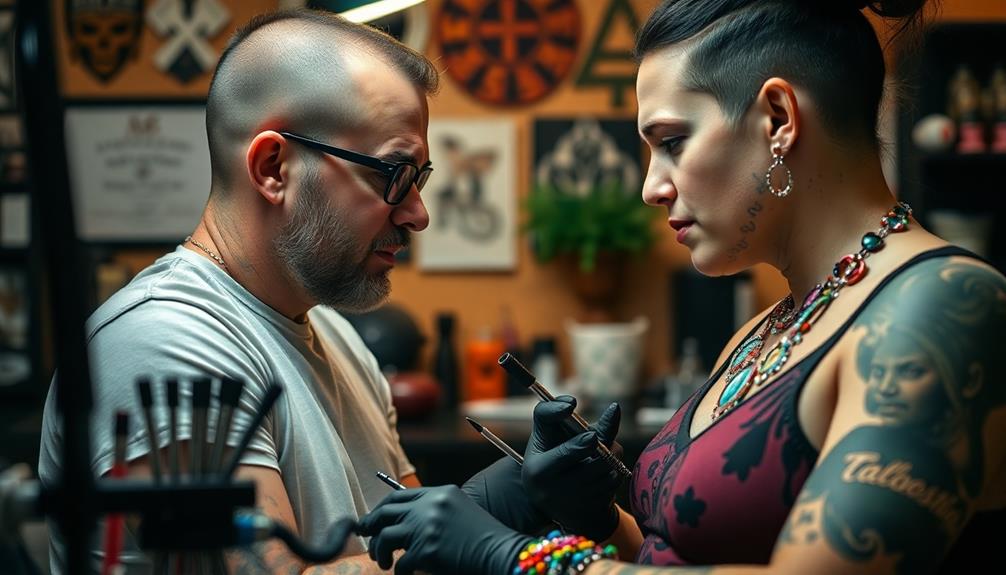
Trust plays an essential role in the relationship between piercers and clients, markedly enhancing the overall experience. When you're getting pierced, effective communication helps clarify the process and safety precautions.
As a client, it's vital to ask questions about the procedure and aftercare. This transparency guarantees you understand the risks and empowers you to make informed decisions.
An ethical piercer will walk you through the entire process, making you feel comfortable and informed about your choice. They should discuss potential side effects and emphasize the importance of ongoing communication.
If you know what to expect, you're more likely to have a positive experience.
Building trust also involves sharing contact information, like an E-mail Address, for any follow-up questions or concerns. This Axiom of accessibility signifies that your piercer values your well-being and is committed to your satisfaction.
Knowledgeable clients tend to adhere better to aftercare recommendations, guaranteeing a healthier healing process. By fostering open dialogue and trust, you can enjoy a more relaxed and fulfilling experience in your body modification journey.
Frequently Asked Questions
Is Free Hand Piercing Better?
Freehand piercing can offer better customization and potentially faster healing, but it requires a skilled piercer. You should weigh the pros and cons, and consult with an experienced professional to determine what's best for you.
What Is the Free Hand Method of Piercing?
The freehand method of piercing feels like an artist painting on a blank canvas. You see a skilled piercer intuitively finding the perfect placement, using only their experience to guide the needle with precision and care.
What Are the Pros and Cons of Piercings?
Piercings can enhance your style and self-expression, but they come with risks like infection and healing complications. It's essential to weigh the aesthetic benefits against potential pain and maintenance before making a decision.
What's the Most Non Painful Piercing?
For the least painful piercing, you should consider earlobe piercings. They're often rated a 1 or 2 on the pain scale, making them a popular choice for beginners who want a relatively comfortable experience.
Conclusion
In the domain of body art, freehand piercing stands as a double-edged sword, offering both a canvas of creativity and potential risks. While the fluidity of this technique can breathe life into your piercing experience, it's essential to weigh the pros and cons carefully. Trust your instincts and the expertise of your piercer, and together, you can transform mere skin into a masterpiece that tells your unique story. Embrace the journey, and let your body shine.
Hi, my name is Danielle, and I’m an author for piercings-body.com. I have a passion for writing and love to share my knowledge on all things body piercing-related. I’m also a huge advocate for safe body modification practices and believe everyone should be able to make informed decisions about their bodies. When I’m not writing or blogging, I enjoy spending time with my family and friends, practicing yoga, and exploring new places.
Advanced Piercing Techniques
Piercing Rejection: Causes, Signs, and Prevention
Learn about piercing rejection, its causes, signs, and prevention methods to keep your piercings safe—discover what you need to know to avoid complications.
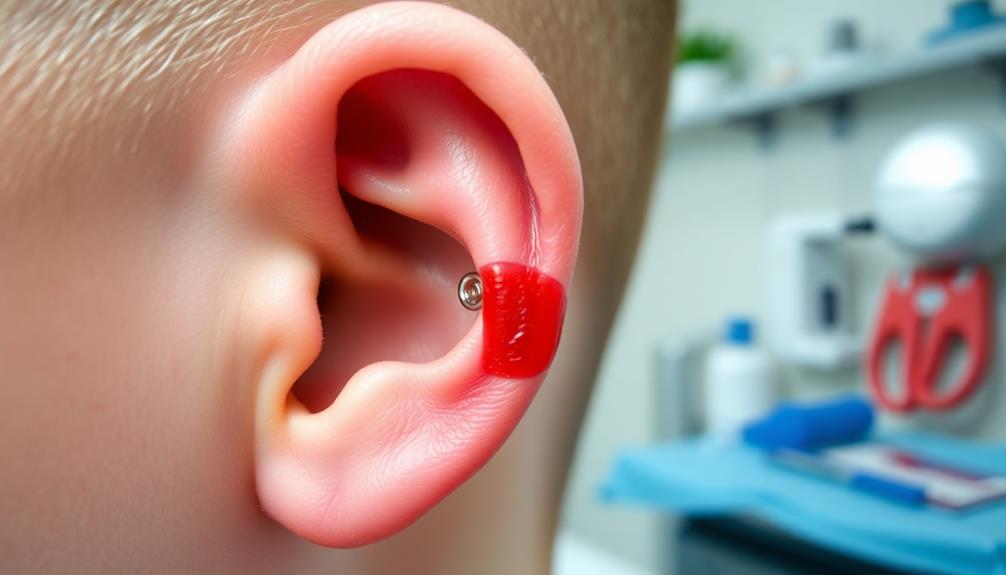
Piercing rejection occurs when your body identifies jewelry as a foreign object. You might notice persistent redness, swelling, or tissue thinning at the piercing site. Low-quality materials, like nickel, can trigger irritation and allergic reactions, increasing rejection risk. Surface piercings and jewelry in high-mobility areas are particularly vulnerable. To avert rejection, choose hypoallergenic materials and monitor your piercing closely for early signs of trouble. Proper aftercare, including regular cleaning and avoiding irritants, is vital. If rejection happens, don't fret; there are effective management strategies you can follow to guarantee better outcomes in the future.
Key Takeaways
- Piercing rejection occurs when the body treats jewelry as a foreign object, often leading to symptoms like redness and swelling.
- Common causes include genetic susceptibility, low-quality jewelry materials, and the location of the piercing on the body.
- Signs of rejection include persistent redness, swelling, excessive discharge, and jewelry migration from its original position.
- Prevention strategies involve choosing hypoallergenic materials, proper aftercare, and monitoring piercings for early signs of irritation.
- Immediate treatment includes cleaning the area, consulting a professional, and potentially removing the jewelry to prevent further complications.
Understanding Piercing Rejection
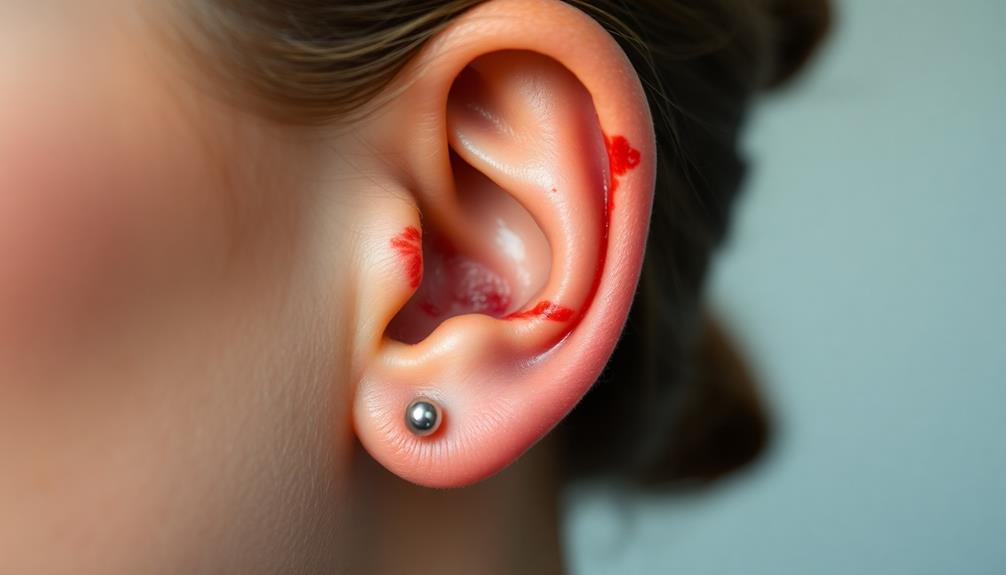
When you get a piercing, it's vital to understand that your body might react to the jewelry as a foreign object. This reaction can lead to piercing rejection, where your body identifies the jewelry as something harmful.
Surface piercings, like those on the nape or eyebrow, are particularly prone to this issue because they don't penetrate deeply into the skin tissue.
You should be aware of the symptoms of rejection, which include persistent redness, swelling, and thinning tissue over the jewelry. If you notice the jewelry moving from its original position, it's a sign that your body might be rejecting the piercing.
Factors such as genetics, improper piercing techniques, and using low-quality or ill-fitting jewelry can increase the risk of rejection.
To minimize this risk, proper aftercare is essential. Follow your piercer's aftercare instructions diligently and keep an eye out for early warning signs.
Understanding these aspects will help you maintain piercing health and prevent complications. By being proactive and informed, you can enjoy your new piercing while reducing the chances of your body rejecting it.
Common Signs of Rejection
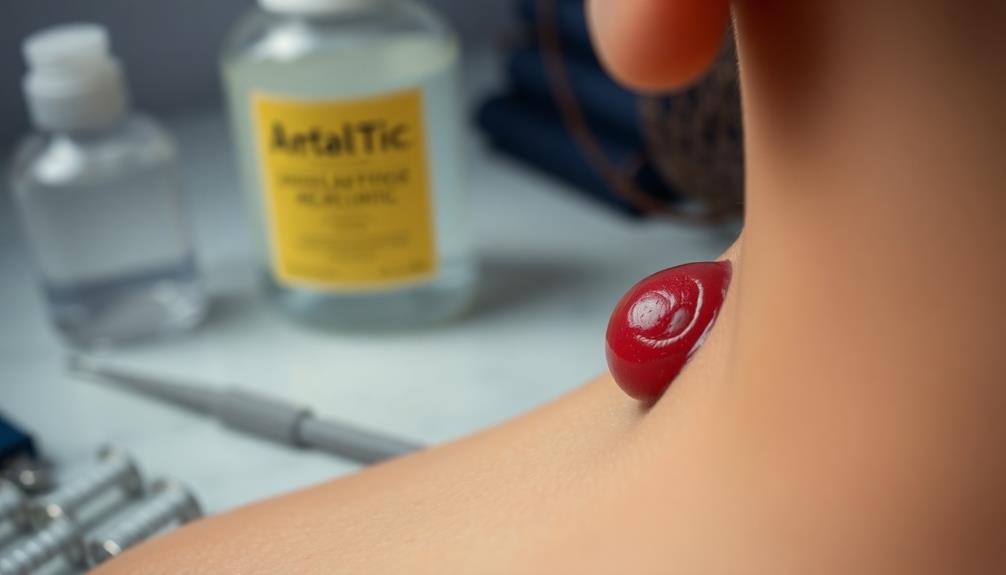
When you notice persistent redness and swelling around your piercing, it might be a sign of rejection.
Excessive discharge or an unpleasant odor can also indicate that something's not right.
Paying attention to these symptoms is essential for addressing potential issues early on.
Redness and Swelling
Redness and swelling are often your body's way of signaling that something isn't quite right with a piercing. These symptoms can indicate inflammation, which is a common initial sign of potential rejection. If you notice persistent redness lasting beyond the typical healing period, it could mean your body is reacting negatively to the jewelry.
| Sign | Possible Cause |
|---|---|
| Redness | Inflammation or rejection |
| Swelling | Infection or rejection |
| Increasing pain | Possible infection |
| Jewelry migration | Sign of rejection |
Swelling accompanied by increasing pain or tenderness should raise red flags, as these can signal an infection or a rejection process. It is vital to monitor these symptoms closely. If you see redness and swelling with changes in jewelry position, like migration, it further supports the possibility of rejection.
Immediate attention to these signs is important. Left untreated, they could evolve into more severe complications. Staying vigilant about your piercing's condition allows you to take action before minor issues escalate into major problems.
Excessive Discharge or Odor
Excessive discharge or an unpleasant odor from a piercing can signal underlying problems, such as rejection or infection. If you notice white, yellow, or brown discharge, it's important to take it seriously. This excessive discharge might indicate your body's immune response to the jewelry, which it perceives as a foreign object.
An unusual odor accompanying the discharge often points to an infection or an inappropriate healing process, frequently linked to piercing rejection.
Keep an eye on any persistent discharge, especially if it's joined by redness or swelling. These symptoms can escalate if left unaddressed. It's important to consult a professional piercer or healthcare provider if you experience these warning signs. They can provide guidance on how to properly care for your piercing and assess whether you're dealing with rejection or an infection.
Maintaining a clean piercing site is essential in preventing complications associated with piercing rejection. Regularly cleaning your piercing and promptly addressing any signs of excessive discharge can make a significant difference in your healing process.
Don't ignore these signs; they're your body's way of communicating that something isn't right.
Key Causes of Rejection
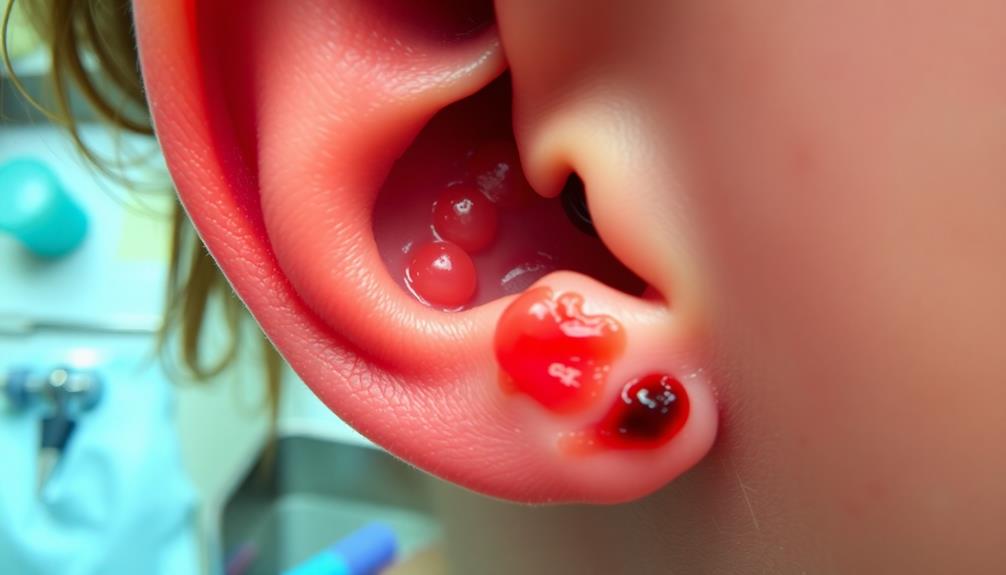
When it comes to piercing rejection, several key factors can play a role in your experience.
Genetic susceptibility can increase your risk, while the quality of jewelry you choose directly impacts your body's reaction.
Additionally, the location of your piercing matters, as certain areas are more prone to rejection than others.
Genetic Susceptibility Factors
Understanding genetic susceptibility factors is essential for anyone considering body piercings, as these hereditary traits can greatly influence healing outcomes.
Genetic factors can markedly impact your body's response to piercings, making you more prone to piercing rejection. If you have a family history of piercing rejection, it might indicate a higher likelihood of experiencing the same issue. Certain genetic conditions that affect skin elasticity or immune system function can also contribute to your body's tendency to reject foreign objects, including jewelry.
Moreover, a history of allergies or sensitivities within your family can heighten the risk of rejection due to potential reactions to various jewelry materials.
It's vital to be aware of these genetic predispositions because they can guide your choices regarding piercing locations and the types of jewelry materials you select. By understanding your unique genetic background, you can take proactive steps to minimize rejection risks and improve your overall experience with body piercings.
Ultimately, being informed about these genetic susceptibility factors can empower you to make better decisions, leading to a more successful healing process and satisfactory results.
Jewelry Material Quality
Choosing the right jewelry material is essential for preventing piercing rejection. Low-quality materials, such as nickel, can cause allergic reactions that increase irritation and rejection risks. Instead, opt for hypoallergenic materials like titanium and surgical stainless steel. These high-quality options are less likely to trigger adverse reactions, especially for those with sensitive skin.
Additionally, make sure your jewelry fits properly. Ill-fitting pieces can lead to friction and pressure, which may result in migration and rejection, particularly in surface piercings. Since these piercings are shallower, they require better support to maintain their position.
To summarize, here's a quick reference table to help you choose the best jewelry material:
| Jewelry Material | Hypoallergenic | Recommendation |
|---|---|---|
| Titanium | Yes | Highly recommended |
| Surgical Stainless Steel | Yes | Highly recommended |
| Nickel | No | Avoid at all costs |
Regularly replacing your jewelry with high-quality options is essential, particularly if you notice any signs of irritation or discomfort. This proactive approach can greatly reduce the likelihood of piercing rejection.
Piercing Location Impact
Certain piercing locations greatly impact the likelihood of rejection, often due to their anatomical characteristics and healing environments. Understanding these factors can help you make informed decisions about where to place your piercings and minimize rejection rates.
Here are some key causes related to piercing location:
- Surface Piercings: Areas like the nape or eyebrow have minimal tissue penetration, leading to fragile healing environments that increase rejection rates.
- Flat Skin Areas: Piercings in places like the navel lack supportive tissue, making them more prone to rejection.
- Tight Skin Areas: Locations such as the wrist or neck experience regular movement or friction, which adds pressure and heightens the risk of rejection.
- High Mobility Areas: Piercings in locations with significant muscle movement, like the tongue, can lead to jewelry migration, further contributing to rejection.
Anatomical factors, including skin thickness and underlying tissue presence, play essential roles in determining rejection risk.
High-Risk Piercing Types
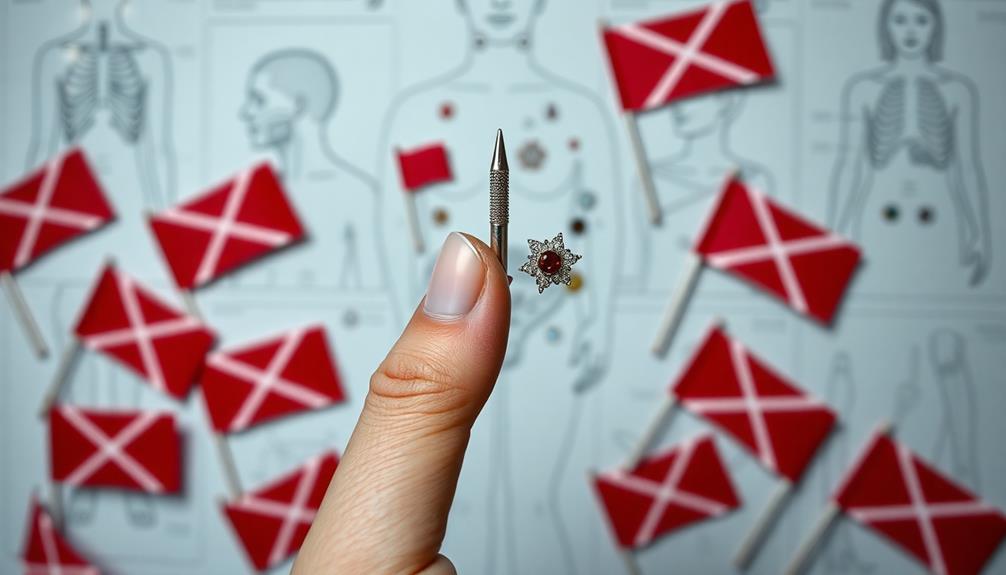
High-risk piercings are those that tend to have a higher chance of rejection due to their placement and the nature of the tissue involved. Surface piercings, like nape and eyebrow piercings, often fall into this category. They've minimal tissue penetration, making them more susceptible to migration and irritation, which can lead to rejection.
Additionally, piercings located in areas with flat or taut skin, such as the navel or wrist, are also prone to rejection. The pressure from the skin can push against the jewelry, resulting in complications.
Cartilage piercings, which have limited support tissue, can heal improperly if not placed correctly, raising the odds of rejection.
Moreover, pregnancy can increase the likelihood of rejection due to hormonal changes affecting skin elasticity and tissue support around the piercing.
Finally, poorly fitted jewelry, especially in sensitive areas like the lip or nostril, can exacerbate rejection rates. It can cause irritation and lead to tissue damage, making it essential to choose the right jewelry for your piercing.
Understanding these high-risk types can help you make informed decisions about your body modifications.
Prevention Strategies
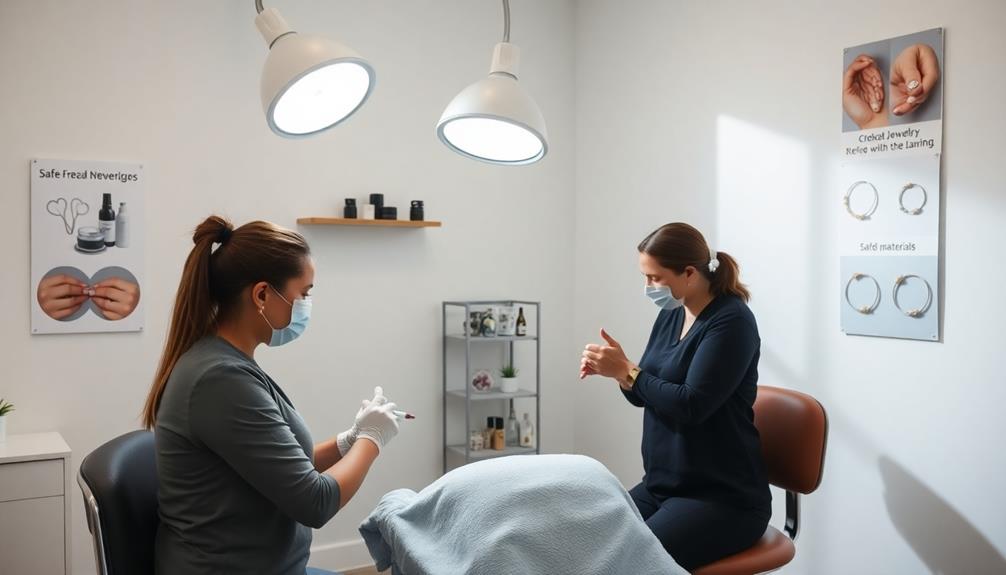
To minimize the risk of rejection in piercings, it's crucial to implement effective prevention strategies. By taking proactive steps, you can help guarantee your piercings heal properly and reduce the chance of complications.
Here are four key strategies to take into account:
- Choose a skilled professional piercer: Confirm your piercer has experience and understands anatomy. Proper techniques can make a significant difference in healing.
- Select high-quality jewelry: Opt for hypoallergenic materials, like titanium or surgical steel. This choice can greatly reduce irritation and the risk of allergic reactions.
- Monitor your piercings regularly: Keep an eye out for signs of irritation, such as persistent redness or swelling. Early detection allows for timely intervention, which can prevent rejection.
- Consult a professional piercer: If you notice any concerning symptoms, reach out to your piercer immediately. Their expertise can guide you in addressing issues before they escalate.
Aftercare for Piercings
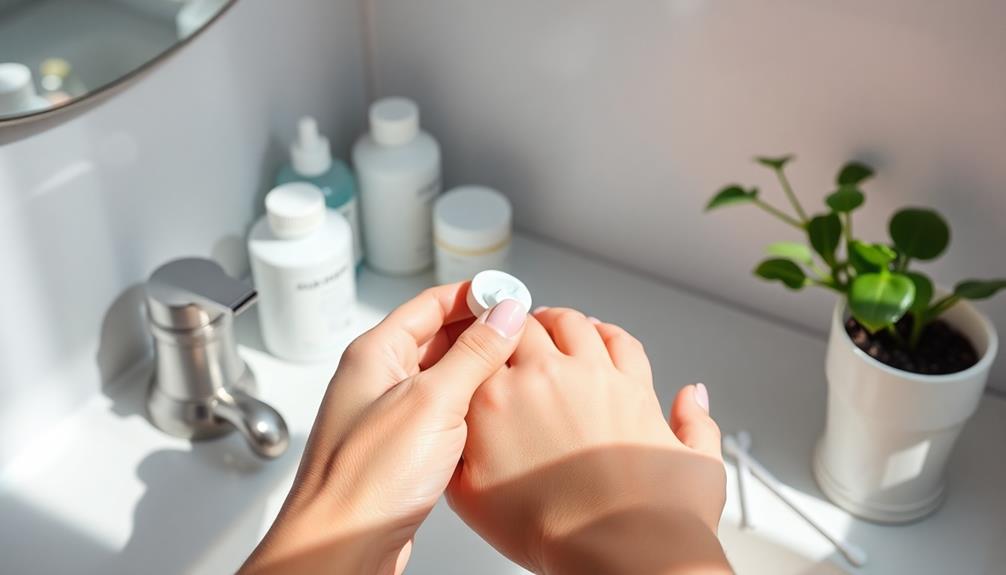
Once you've had a piercing done, proper aftercare is essential for ensuring it heals well and avoids complications. Start by cleaning the piercing site with a mild saline solution or soap and water. This helps prevent infection and supports your healing process.
Always wash your hands before touching the area, and avoid irritants like makeup, hair products, and perfumes during this time.
Follow any specific aftercare instructions your piercer provides, including avoiding swimming pools, lakes, and other bodies of water until the piercing is fully healed.
Moisturizing the area with non-irritating products, such as vitamin E oil, can minimize scarring if rejection occurs from improper aftercare.
Regularly monitor the piercing for signs of infection, such as excessive redness, swelling, or discharge. If you notice any concerning symptoms, consult a professional immediately.
By staying vigilant and adhering to these aftercare guidelines, you can effectively prevent complications and promote a smooth healing process.
Addressing Infections
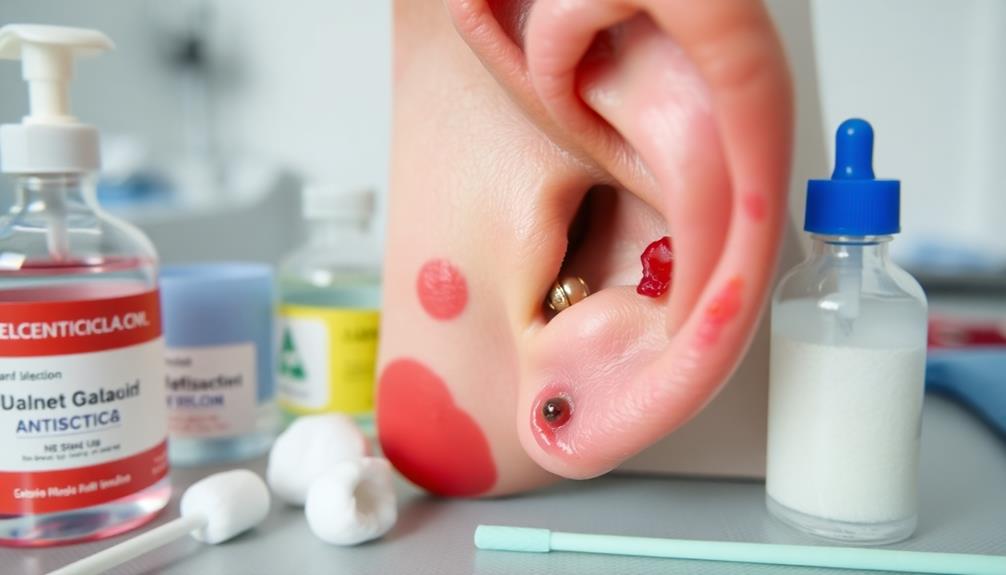
When it comes to piercings, recognizing the symptoms of infection is key to quick recovery.
The use of hydrocolloid patches can be beneficial for treating minor irritation around the piercing site, as they help draw out impurities and create a protective barrier.
If you notice redness, swelling, or discharge, it's important to treat the area immediately and seek professional advice if symptoms worsen.
Plus, practicing good hygiene and regular check-ups can help you prevent infections in the long run.
Identifying Infection Symptoms
Identifying infection symptoms in a piercing is vital for guaranteeing your health and safety. Recognizing these signs early can help you take action before complications arise. Here are some key symptoms to watch for:
- Redness: Look for increased redness around the piercing site, which indicates inflammation.
- Swelling: If you notice significant swelling, it could be a sign of infection, especially if it worsens over time.
- Tenderness: Persistent pain or tenderness surrounding the piercing, particularly if it escalates, can signal an infection.
- Discharge: Any unusual discharge, especially if it's white, yellow, or brown, may indicate infection and requires immediate attention.
Infections often present more pronounced symptoms than simple irritation, so differentiating between the two is essential.
Additionally, be mindful of systemic symptoms like fever or rapid heart rate, as they may indicate a more serious condition.
If you observe any of these symptoms, it's important to consult a healthcare professional promptly to guarantee proper care and prevent further complications.
Prioritizing your health will help you enjoy your piercing safely.
Immediate Treatment Options
If you notice signs of infection in your piercing, acting quickly can make a significant difference in your recovery. First, evaluate the symptoms—look for redness, swelling, or discharge.
Start immediate treatment by cleaning the area with a saline solution. This can help reduce the risk of further complications. While it may be necessary to remove the jewelry if the infection worsens, always consult a professional piercer first. They can guide you on the best course of action without exacerbating the situation.
Applying topical antibiotics can be beneficial, but it's essential to consult a healthcare provider for proper treatment recommendations tailored to your specific case.
If you experience persistent symptoms, like fever or systemic malaise, don't hesitate to seek prompt medical attention to prevent further health issues.
Regularly monitoring your piercing and documenting any changes can also aid in evaluating the infection's progression. This information will be valuable during consultations with your healthcare provider.
Long-term Prevention Strategies
Taking proactive steps can considerably reduce the risk of infections in your piercings. To guarantee your piercings heal properly and minimize complications, follow these essential strategies:
- Clean piercings regularly with a saline solution or mild soap and water. This routine helps prevent infection and promotes healing.
- Avoid harsh cleansers or alcohol-based products, as these can irritate the skin and increase the risk of infection.
- Keep piercings dry and refrain from submerging them in water, like pools or hot tubs, during the healing process to reduce bacterial exposure.
- Monitor symptoms closely for any signs of infection, such as increased redness, swelling, or discharge. If you notice these rejection signs, seek advice from a professional piercer.
Additionally, schedule follow-up appointments with your professional piercer to assess the healing process and address any concerns.
Treatment Options for Rejection
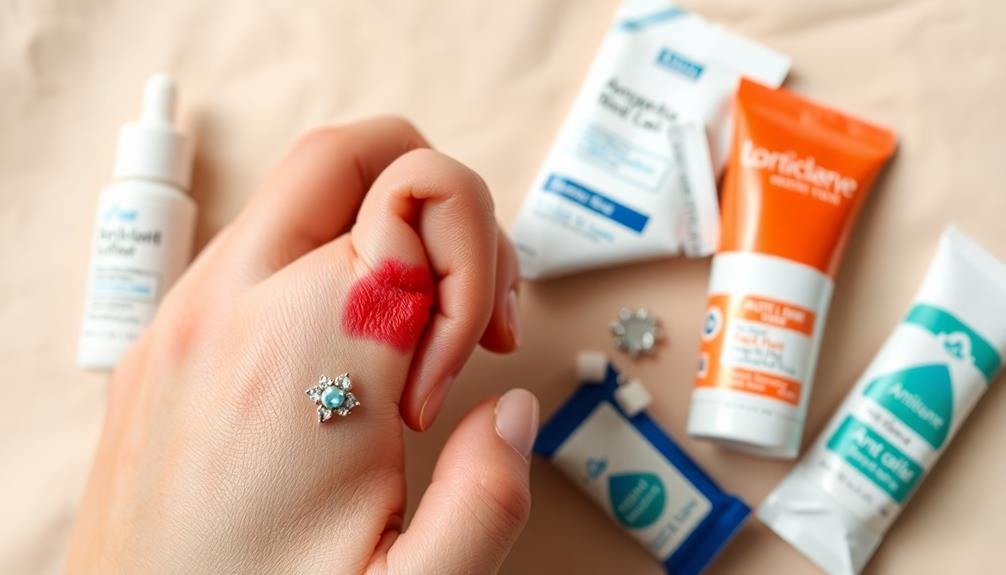
When faced with piercing rejection, swift action is essential to minimize complications and promote healing. First, you should remove the piercing immediately to prevent further migration and potential scarring.
After removal, it's important to clean the area daily with mild soap and water to maintain hygiene and reduce the risk of infection.
To aid in the healing process, consider applying topical ointments like petroleum jelly. This can help promote healing and minimize scarring at the site.
However, if you notice any signs of infection—such as increased redness, swelling, or pus—it's critical to consult a healthcare provider for medical advice. They may recommend antibiotic treatment to address any infection that develops post-removal.
In some cases, a loop suture might be inserted to keep the piercing hole open and prevent closure during healing. This option can be discussed with your healthcare provider.
Remember, taking these steps not only helps in managing piercing rejection but also guarantees that your skin heals properly and remains healthy.
Prioritizing care after rejection will set you up for better outcomes in the future.
Monitoring Healing Progress
To guarantee your piercing heals properly, it's crucial to regularly monitor the healing progress. Keeping an eye on your piercing can help you catch issues early, ensuring a smoother healing experience.
Here are some key aspects to focus on:
- Signs of Irritation or Infection: Regularly inspect the piercing site for redness, swelling, or discharge. These could indicate infection or irritation that needs addressing.
- Jewelry's Position: Check the jewelry's position frequently. Any migration, especially in surface piercings, can signal potential rejection.
- Skin Texture Changes: Look for changes around the piercing, like thinning tissue or irritation bumps. These changes can indicate complications that may need professional attention.
- Documentation and Follow-ups: Keep a journal detailing any symptoms or appearance changes. This record can be invaluable during follow-up appointments with your piercer.
Choosing the Right Piercer
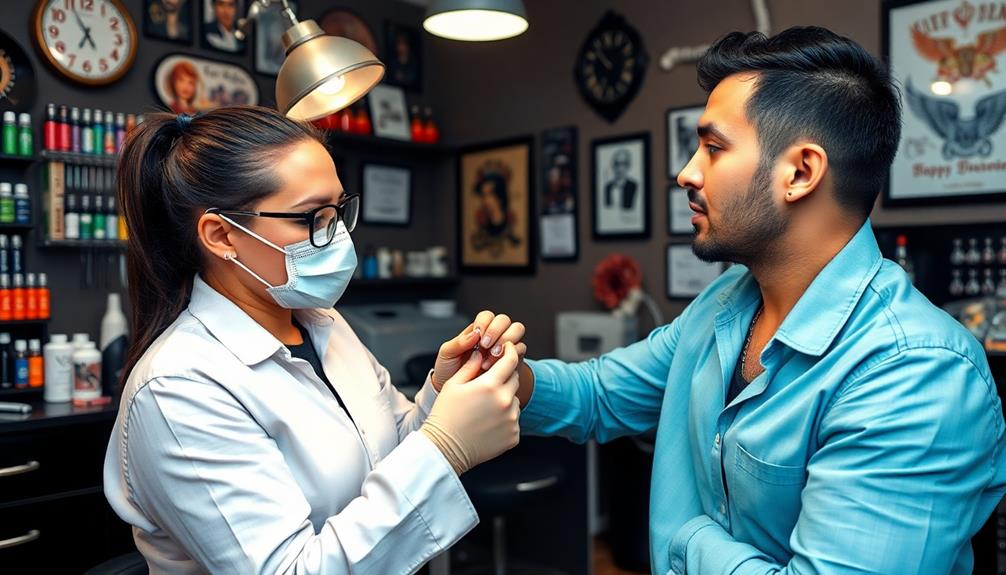
Choosing the right piercer can make all the difference in your piercing experience and healing process. A qualified piercer with extensive experience and positive reviews greatly reduces the risk of rejection. They'll guarantee proper technique and provide the guidance you need for effective aftercare.
When you're looking for a piercer, ask about their sterilization practices and whether they use high-quality, hypoallergenic materials. This is essential to prevent allergic reactions and irritation in your newly pierced area.
You should also consider a piercer who can assess your anatomy to determine the best location for your piercing. This assessment is important for minimizing rejection risks.
Additionally, a professional piercer should have a portfolio showcasing successful piercings in similar locations. This indicates they're familiar with the specific challenges those areas present.
Don't forget to inquire about personalized aftercare instructions tailored to your piercing type, as this will promote healing and help you avoid complications.
Frequently Asked Questions
Can Piercing Rejection Happen Years After the Initial Piercing?
Yes, piercing rejection can happen years after the initial piercing. Your body's response to the jewelry, changes in skin condition, or weight fluctuations can trigger rejection even long after you've gotten used to it.
Are Certain Body Types More Prone to Piercing Rejection?
Some body types seem to attract piercing rejection like moths to a flame. If you've got sensitive skin or unique body chemistry, you might be more likely to experience issues with your piercings over time.
Does the Age of the Individual Affect Rejection Rates?
Yes, age can affect rejection rates. Younger skin tends to heal faster and more effectively, while older skin may have a slower healing process, leading to increased risk of complications and rejection in piercings.
Can Allergies to Metals Cause Rejection in Piercings?
Yes, allergies to metals can definitely cause rejection in piercings. If you're allergic, your body might react negatively to the metal, leading to irritation, swelling, or even the piercing being pushed out over time.
What Should I Do if I Suspect My Piercing Is Rejecting?
If you suspect your piercing's rejecting, clean it gently, avoid irritating it, and switch to a hypoallergenic jewelry. Consult a professional piercer or dermatologist for advice on managing the situation and preventing further issues.
Conclusion
In the world of body art, your skin is a canvas, and rejection can feel like a storm cloud overshadowing your masterpiece. By understanding the signs and causes, you can steer clear of this turbulence. Remember, choosing the right piercer is like selecting a skilled artist, ensuring your vision comes to life without a hitch. With the right care and vigilance, you can keep your piercing shining bright, turning your body into a true work of art.
Hi, my name is Danielle, and I’m an author for piercings-body.com. I have a passion for writing and love to share my knowledge on all things body piercing-related. I’m also a huge advocate for safe body modification practices and believe everyone should be able to make informed decisions about their bodies. When I’m not writing or blogging, I enjoy spending time with my family and friends, practicing yoga, and exploring new places.
Advanced Piercing Techniques
Advanced Aftercare for Complex Piercings
Optimize your complex piercing recovery with advanced aftercare tips—discover the essential products that can make all the difference in your healing journey.
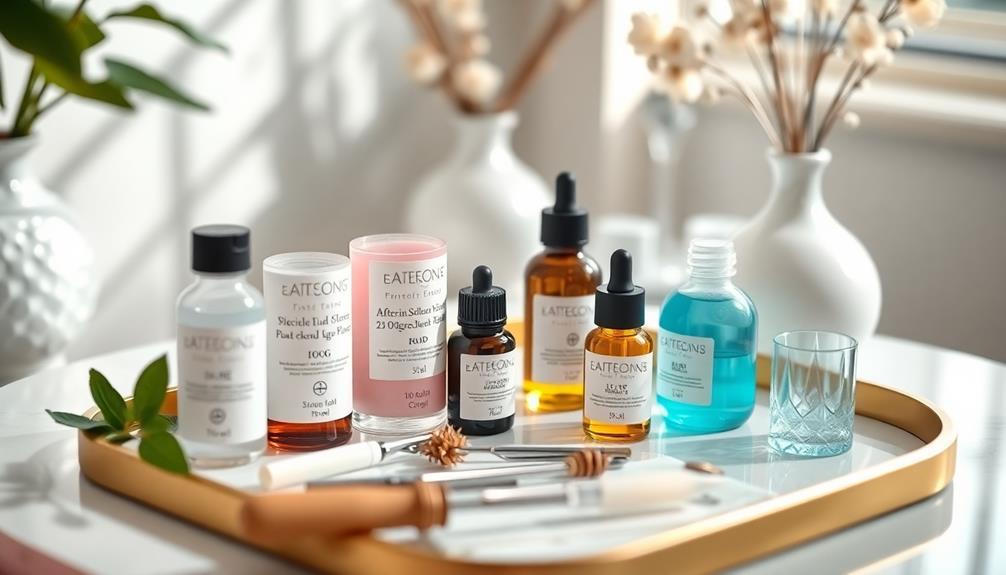
Advanced aftercare for complex piercings, like cartilage or daith, is vital for quicker healing and fewer complications. Clean your piercings twice a day with glycerin-based soap and follow up with a hypoallergenic aftercare solution to reduce irritation. Always use implant-grade jewelry to minimize allergic reactions. Avoid tight clothing and high-impact activities that can irritate the area. Keep an eye out for signs of infection, such as unusual discharge or persistent pain. With the right techniques and products, you can guarantee a smoother recovery. Want to know which specific products work best for you?
Key Takeaways
- Maintain a rigorous cleaning routine by using hypoallergenic solutions twice daily to reduce irritation and promote faster healing.
- Choose implant-grade jewelry materials like titanium to minimize the risk of allergic reactions and infections during the healing process.
- Avoid touching or changing jewelry until fully healed to prevent complications such as tearing, migration, or infection.
- Be mindful of lifestyle factors, such as avoiding tight clothing and high-impact activities, which can irritate the piercing and prolong healing.
- Regularly inspect the piercing for signs of infection, such as unusual discharge or increasing redness, and seek medical advice if needed.
Understanding Complex Piercings
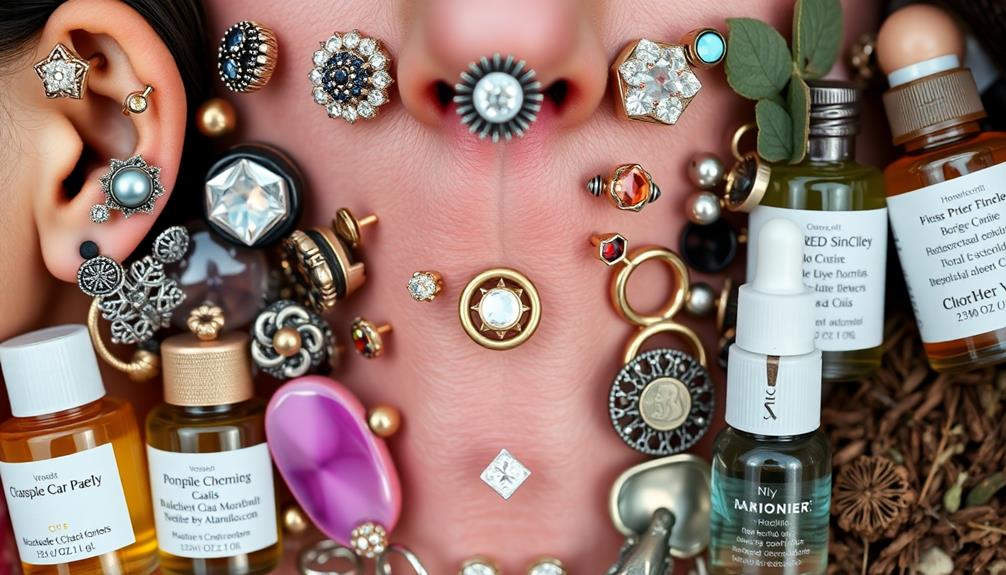
When you consider getting a complex piercing, such as a helix or daith, it's essential to understand the unique challenges they present. Unlike lobe piercings, cartilage piercings often have longer healing times, typically ranging from 3 to 12 months. This extended period can be influenced by individual factors and the specific area of the piercing.
Multiple piercings in close proximity can increase the risk of irritation and infection, making a rigorous aftercare routine imperative. You'll need to pay close attention to how the area responds during the healing process.
Proper jewelry selection is important, too; using implant-grade materials minimizes the chances of allergic reactions and supports healing.
Be cautious about changing your jewelry too soon, as premature changes can lead to complications like tearing or migration of the fistula. Ensuring your jewelry is suitable and leaving it in place until fully healed can markedly impact your recovery.
Understanding these factors can help you navigate the complexities of healing and enjoy your new piercings without unnecessary complications.
Importance of Aftercare
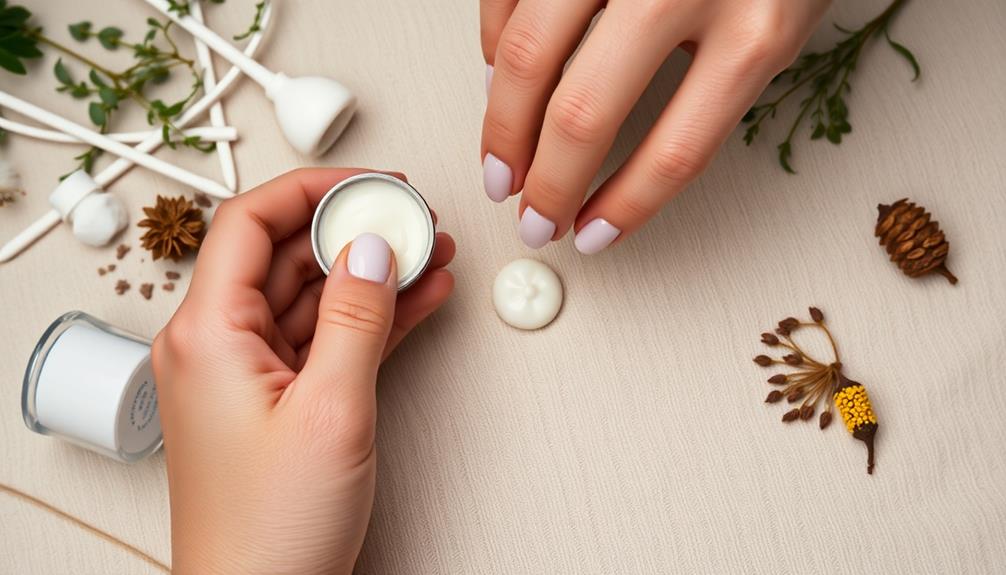
Aftercare is essential for guaranteeing your complex piercings heal properly and quickly. With proper aftercare, you can reduce the typical healing time from 6-8 weeks to as little as 3 weeks, especially when using effective products like Studex Advanced 2-in-1 Aftercare.
Consistent cleaning and soothing of the piercing area are critical to prevent infections and complications, as neglecting hygiene increases the risk of infection.
Utilizing a hypoallergenic aftercare solution is crucial, particularly for those with sensitive skin, as it minimizes irritation and discomfort. This attention to aftercare not only supports healing but also maintains the appearance and hygiene of your jewelry, greatly lowering the chances of keloids and scarring.
Following a structured aftercare routine, which includes cleaning your piercings twice daily, is key for ideal healing. This regular care helps guarantee that your skin remains healthy and intact around the piercing.
Recommended Aftercare Products
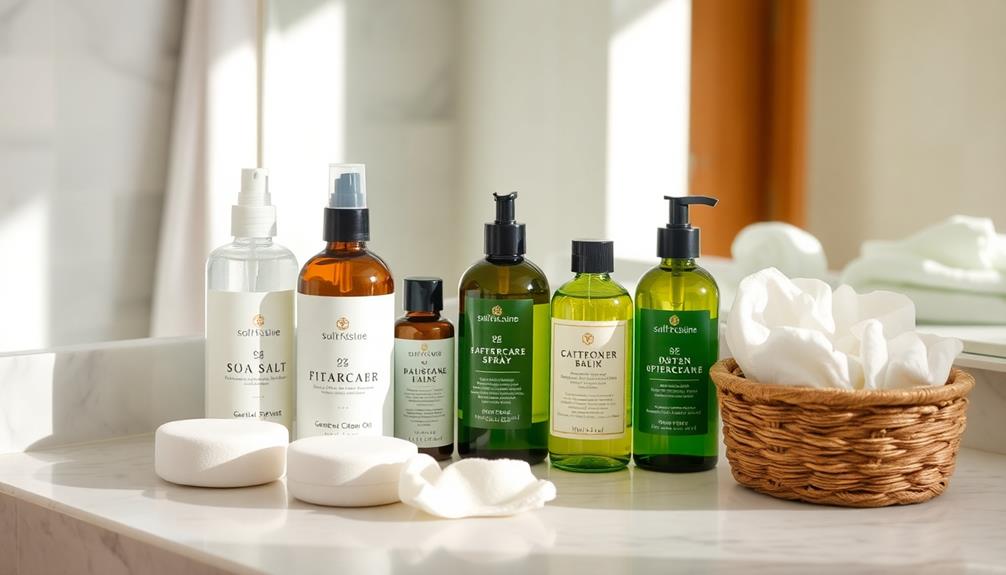
Choosing the right aftercare products is essential for ensuring your complex piercings heal efficiently and effectively. One standout option is the Studex Advanced 2-in-1 Piercing Aftercare & Cleanser. This product is specifically formulated for rapid recovery, making it ideal for various complex piercings like helix and daith.
What sets this aftercare solution apart is its hypochlorous formula, which not only cleanses but also calms broken skin. Users have reported significant improvements in healing times compared to traditional saline solutions, with notable results within just three weeks.
Plus, it's dermatologist tested and pediatrician tested, so you can trust it for sensitive skin. Being hypoallergenic and alcohol-free means you can safely use this aftercare spray daily without worrying about irritation.
For optimal outcomes, apply it twice a day to maintain hygiene and enhance infection prevention. This targeted approach to aftercare can make a world of difference, providing you with the best chance for smooth healing and minimizing discomfort.
Choose this advanced aftercare product to support your piercing journey effectively!
Cleaning Techniques for Piercings
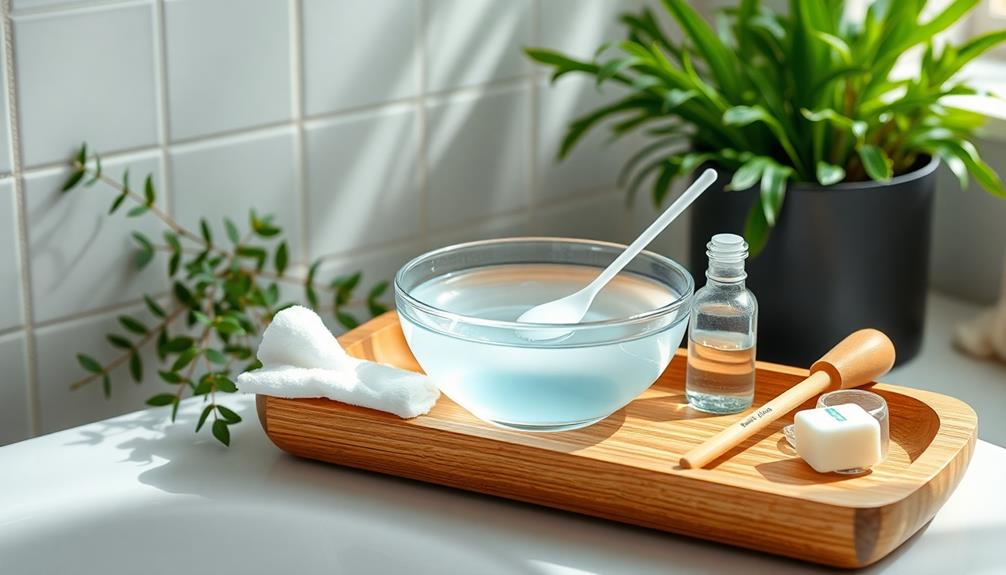
Your piercing's healing process greatly relies on effective cleaning techniques. Start by making certain your hands are clean; wash them thoroughly before touching the piercing to prevent bacteria from entering the area.
Use a gentle, glycerin-based medical soap to clean the piercing twice a day. After the soap application, spray the Studex Advanced 2-in-1 Piercing Aftercare & Cleanser directly onto the piercing and let it air dry. This helps promote healing.
Avoid using cloth towels, as they can harbor bacteria. Instead, use sterile gauze to gently pat the area dry. During the cleaning process, gently twist and glide the jewelry to make sure the solution reaches all areas, effectively removing any accumulated debris.
After cleaning, make sure to rinse the area thoroughly to eliminate any residual soap. Soap left on the skin can irritate and potentially interfere with the healing process.
Following these cleaning techniques diligently will greatly enhance your piercing aftercare, supporting a smoother healing journey. Remember, consistency is key to maintaining a healthy piercing!
Common Healing Challenges
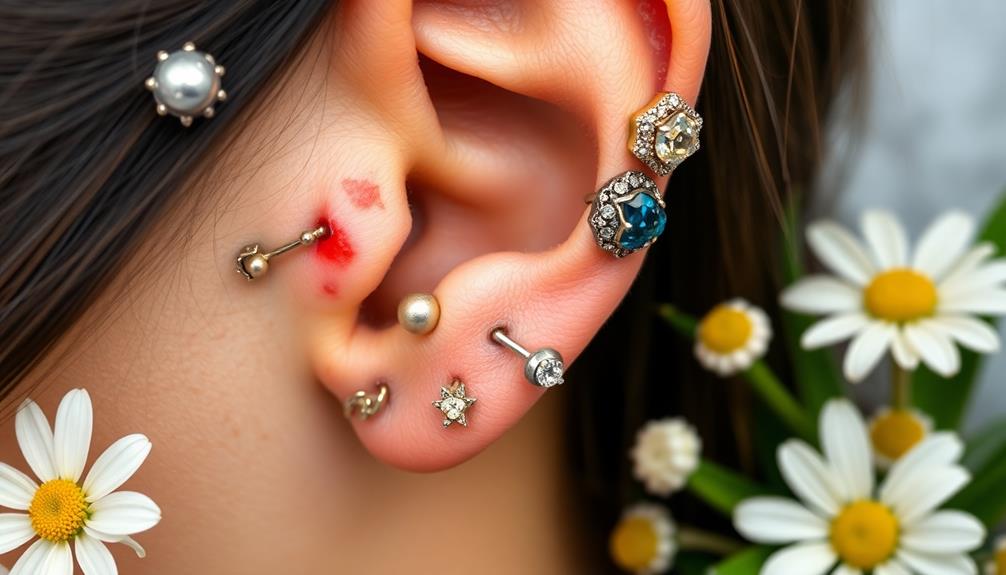
Healing a complex piercing can come with its own set of challenges, even when you've followed the right cleaning techniques. The healing process for piercings like daith or helix can take up to 12 months, and during this time, you might face several issues:
- Increased tenderness and swelling: This is common and can be exacerbated by improper aftercare. Regular cleaning and avoiding irritants can help mitigate these symptoms, as outlined in piercing care and hygiene.
- Irritation from non-hypoallergenic jewelry: Always opt for hypoallergenic materials to minimize discomfort.
- Keloid formation: If you're prone to scarring, using skin-neutral pH aftercare products is necessary.
- Bumps mistaken for infection: These often result from irritation or inadequate cleaning, so a consistent aftercare regimen is vital.
Pay attention to these healing challenges to guarantee a smooth recovery. Engage in careful lifestyle considerations, as factors like sleeping positions or wearing helmets can impede healing.
Lifestyle Factors Affecting Healing

Your daily activities and clothing choices play a significant role in how quickly your piercings heal.
Tight clothing can cause irritation, while workouts or sports might increase swelling and delay recovery.
Being mindful of these factors can make a big difference in your healing journey.
Daily Activity Considerations
When steering through daily activities after getting a complex piercing, it's vital to reflect on how your lifestyle can impact the healing process. Certain actions can hinder piercing healing and lead to complications. Here are four key considerations:
- Avoid high-impact sports: Engaging in activities that create friction and pressure on piercings can extend healing time and increase the risk of irritation.
- Be cautious with clothing: Tight clothing, like high-waisted pants, may irritate body piercings and impede proper healing due to constant friction against the skin.
- Swimming is risky: Activities like swimming in fresh or saltwater before complete healing can introduce harmful bacteria, greatly raising the risk of infection.
- Consider headgear use: Helmets or other headgear can put pressure on ear piercings, requiring you to think carefully about when to participate in such activities to avoid irritation and delayed healing.
Maintaining a consistent cleaning routine and steering clear of excessive movement or touching of the piercing is vital during this time.
These measures will help guarantee ideal healing and reduce the chances of complications.
Clothing and Piercing Care
After getting a complex piercing, the choice of clothing plays an important role in the healing process. Tight or restrictive clothing, like high-waisted pants, can create friction and pressure on your fresh piercings, potentially prolonging healing.
It's vital to select loose-fitting options to minimize this risk. If you're wearing headgear, such as helmets, be cautious; they can irritate ear piercings, leading to swelling and discomfort.
To guarantee comfort and support healing, opt for soft, breathable fabrics. Regularly changing your clothing style can also help reduce irritation, allowing your piercings to heal more effectively.
If you lead an active lifestyle or participate in contact sports, you'll need to plan around your healing times. This means being mindful of how your clothes interact with your piercings to prevent complications.
Taking care of your clothing choices can make a significant difference in your healing journey. By prioritizing comfort and choosing fabrics that breathe, you'll help avoid unnecessary friction and irritation, promoting a smoother healing experience for your new piercings.
Signs of Infection to Watch For

Keeping an eye out for signs of infection is essential after getting a complex piercing. Being proactive can help you address issues before they escalate. Here are four key symptoms to watch for:
- Increased Redness and Swelling: If you notice more redness or swelling around the piercing site, it could indicate inflammation that needs attention.
- Unusual Discharge: Pus or discharge—especially if it's green or yellow—is a strong sign of infection that shouldn't be ignored.
- Persistent Pain or Tenderness: If the pain or tenderness worsens over time, rather than improving, it's often a warning signal of an infection.
- Systemic Symptoms: Fever or other systemic symptoms accompanying local signs may indicate a more serious issue. Seeking medical advice promptly is vital.
Additionally, if you experience increased sensitivity or unbearable itchiness, it might signal an allergic reaction or infection.
Staying vigilant about these signs can make a significant difference in your healing process, so don't hesitate to consult a professional if you have concerns. Your health and comfort should always come first!
Best Practices for Jewelry Care

To guarantee your complex piercing heals properly and stays looking great, proper jewelry care is essential. Always choose implant-grade jewelry materials, like titanium or surgical stainless steel, to minimize the risk of allergic reactions and support the healing process.
Regular cleaning is vital, so use a gentle, hypoallergenic cleanser such as Studex Advanced 2-in-1 Piercing Aftercare & Cleanser to remove dirt and bacteria that can lead to infections.
It's important to avoid changing jewelry too soon; wait until your piercing is fully healed, which can take several weeks to months, depending on the type.
To maintain your jewelry's appearance, steer clear of harsh chemicals or cosmetics, and store pieces in a clean, dry place when not in use to prevent tarnishing and buildup.
Regularly inspect your jewelry for signs of wear or irritation. If you notice any discomfort or changes, consult a professional piercer for advice on care and potential adjustments.
Following these best practices won't only protect your piercing but also enhance the overall longevity and beauty of your jewelry.
Adjusting Aftercare for Different Piercings
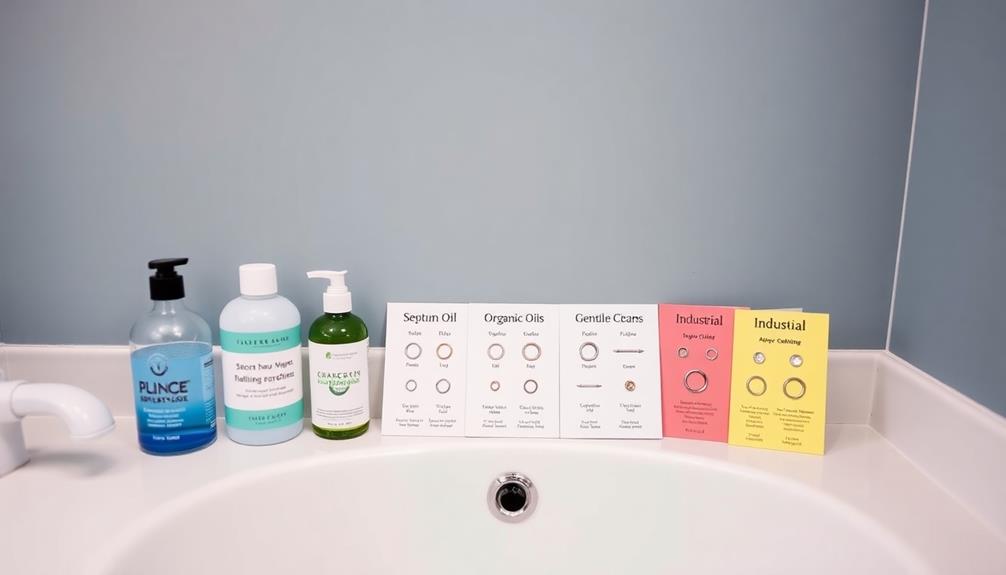
When it comes to aftercare, each piercing requires its own specific approach.
You'll need to tailor your techniques based on the type of piercing you have, whether it's a simple lobe or a more complex industrial.
Specific Piercing Considerations
Aftercare for different types of piercings requires tailored approaches to guarantee ideal healing. Each piercing type has unique considerations that you should be aware of:
- Helix Piercings: Expect a healing time of up to 8 weeks due to the slower recovery of cartilage.
- Conch Piercings: Maintain rigorous cleaning and avoid pressure from headphones to prevent irritation and prolonged healing.
- Daith Piercings: These can take 6 months or more to heal, so careful aftercare practices are vital to avoid complications.
- Belly Button Piercings: Healing time varies widely, generally from 6 months to a year, depending on individual health factors.
Using a gentle cleanser like Studex Advanced can be particularly effective for your complex piercings. This hypochlorous spray not only cleanses but also soothes the skin, minimizing irritation during the healing process.
Adapting your aftercare routine based on the specific piercing guarantees you take the right steps for peak recovery. Remember, consistent aftercare practices are essential for all piercings, especially those involving cartilage, to facilitate proper healing and avoid complications.
Tailored Aftercare Techniques
Tailoring your aftercare techniques is essential for guaranteeing ideal healing of your piercing. For cartilage piercings like helix and conch, you'll need to commit to extensive care for up to 8 weeks. Regularly clean these areas with a gentle solution like Studex Advanced to prevent irritation and infection.
When it comes to daith piercings, focus on keeping the area dry and clean, applying aftercare spray twice daily, and avoiding unnecessary movement of the jewelry to support the healing process.
Cartilage piercings can be particularly sensitive, so opt for hypoallergenic, alcohol-free products to minimize the risk of keloids and scarring. Surface piercings require extra caution; pay attention to the surrounding skin to prevent bumps and irritation. Use a gentle cleanser and maintain proper hygiene to guarantee a smooth healing journey.
Always consult a professional piercer for personalized aftercare advice, as healing times and techniques can vary greatly. By adjusting your aftercare techniques according to the specific type of piercing, you'll promote healing and greatly reduce the chances of complications.
User Experiences and Testimonials

Many users have shared their positive experiences with the Studex Advanced 2-in-1 Piercing Aftercare & Cleanser, highlighting how it speeds up healing times considerably.
Many find that incorporating calming elements, such as aromatherapy for stress relief, enhances their overall aftercare routine, promoting relaxation during the healing process.
Here's what you can expect based on testimonials from fellow users:
- Faster Healing: Many report complete recovery in as little as three weeks, which is impressive for various piercing types.
- Pain-Free Experience: Users consistently note minimal irritation and discomfort, making aftercare much more manageable.
- Gentleness on Sensitive Skin: The hypoallergenic formula is a hit for those with sensitive skin, allowing for daily use without any adverse reactions.
- Ease of Application for Children: Parents appreciate how easy it's to apply, encouraging kids to stick to their aftercare routines.
These testimonials showcase the effectiveness of Studex Advanced in not just promoting skin restoration but also enhancing your overall aftercare experience.
Users have found it superior to traditional saline solutions, effectively reducing bumps and ensuring a smoother healing process.
If you're looking for reliable piercing aftercare, you might want to contemplate giving Studex Advanced a try!
Frequently Asked Questions
What Is the Hardest Piercing to Take Care Of?
The hardest piercing to take care of is often the industrial piercing. It's more susceptible to irritation and infection due to its unique structure, requiring you to be extra cautious with cleaning and movement.
Can You Use Advanced Wound Wash on Piercings?
Yes, you can use advanced wound wash on piercings. It cleanses and calms the area, promoting faster healing. Just apply it twice daily to support your skin's recovery and reduce irritation effectively.
What Is the Best Aftercare for Piercings?
The best aftercare for piercings involves cleaning them twice daily with a gentle solution, avoiding unclean water, and keeping the area free from irritation. Consistent care speeds up healing and prevents complications. You'll see results!
What Is the Best Thing for Healing Piercings?
To heal your piercings effectively, use a gentle, hypoallergenic cleanser twice daily. Keep the area clean, avoid touching it, and follow aftercare instructions closely to promote faster healing and minimize irritation or infections.
Conclusion
In summary, taking care of complex piercings is essential for a smooth healing process. Did you know that around 30% of people experience complications with their piercings? By following the right aftercare steps and being vigilant, you can greatly reduce your risk. Remember, your body deserves the best treatment, so invest time in your aftercare routine. With patience and the right products, you'll enjoy your unique piercings for years to come, free from unnecessary issues.
Hi, my name is Danielle, and I’m an author for piercings-body.com. I have a passion for writing and love to share my knowledge on all things body piercing-related. I’m also a huge advocate for safe body modification practices and believe everyone should be able to make informed decisions about their bodies. When I’m not writing or blogging, I enjoy spending time with my family and friends, practicing yoga, and exploring new places.
Advanced Piercing Techniques
The Role of Anatomy in Successful Piercings
Consider how your unique anatomy influences piercing success and discover essential insights that can transform your experience. What will you learn next?

Understanding anatomy is vital for successful piercings. Your tissue thickness and unique features influence the placement and healing process. For instance, areas like the navel and nipple may need specialized techniques due to their anatomical characteristics. A professional piercer assesses your individual anatomy to minimize risks and complications, ensuring the right jewelry and technique are used. This knowledge helps avoid issues like excessive bleeding or infections, promoting quicker healing. With the right approach, you can not only enjoy your new piercing but also feel confident about its success. There's plenty more to discover about making informed choices for your piercing journey.
Key Takeaways
- Individual anatomical features, such as tissue thickness and location, significantly impact the success and healing of piercings.
- Professional evaluations ensure anatomical compatibility, minimizing risks associated with specific piercing types.
- Different body areas require tailored techniques and jewelry selections based on unique anatomical characteristics.
- Understanding anatomy helps prevent complications, such as excessive bleeding and infection, during and after the piercing process.
- Cultural perspectives and personal aesthetics linked to piercings reflect diverse meanings, highlighting the importance of anatomy in self-expression.
Importance of Anatomy in Piercings

Understanding anatomy is vital when it comes to piercings. Your individual anatomical features, like tissue thickness and defined ridges, markedly impact the success of any piercing. Proper anatomy plays an essential role in determining whether a specific location can support a piercing without complications.
For instance, certain areas like the nipple and navel demand particular anatomical characteristics, such as protrusion and defined upper ridges, to guarantee a successful piercing and minimize healing issues.
When you undergo a professional assessment of your anatomy, it can reveal potential risks associated with different piercings. This evaluation allows for tailored advice on jewelry selection, enhancing your comfort and promoting effective healing.
Recognizing the significance of anatomical compatibility is key; not every body part is suitable for piercing, and individual variations can greatly influence outcomes.
Types of Body Piercings

Body piercings come in various forms, each with unique characteristics and considerations. Understanding the specific anatomy involved is vital for achieving successful placements. Here are three common types of body piercings you might consider:
- Ear Piercings: These can include lobe and cartilage piercings, each requiring different techniques. Cartilage, for example, is rigid and may lead to complications if not handled properly by a professional piercer.
- Nose and Lip Piercings: These facial piercings often heal within 4 to 8 weeks, but they require careful attention to the anatomy of the nasal and oral regions to avoid infection and guarantee proper placement.
- Genital Piercings: These involve complex anatomical structures and come with higher risk factors. A thorough understanding of the anatomy is essential for a safe and successful procedure.
Each type of piercing has its own healing time, generally ranging from 4 to 12 weeks, influenced by the unique anatomical features of the site.
Always consult a professional piercer who understands these nuances for the best results.
Health and Safety Measures

Safety should always be a top priority when it comes to body piercings. Implementing effective health and safety measures is essential to minimize complications and guarantee a successful outcome.
Start by confirming that all piercing equipment is properly sterilized, ideally through autoclaving, and use single-use items whenever possible to reduce the risk of infection and transmission of bloodborne pathogens. Additionally, maintaining good oral health with essential oils for toothache relief can aid in overall hygiene, which is fundamental for healing.
Understanding the anatomy of the piercing site is necessary. A professional piercer should evaluate your individual anatomy to confirm the chosen site is safe and suitable, which helps prevent excessive bleeding and complications. They'll also consider vascular structures and nerve endings to avoid unnecessary harm.
After your piercing, keep an eye out for signs of infection, like redness, swelling, or discharge. Healing can take anywhere from 4 to 12 weeks, so regular monitoring is key.
Additionally, choose hypoallergenic jewelry materials, such as titanium or surgical stainless steel, to prevent allergic reactions. By adhering to these health and safety measures, you can greatly reduce the risk of migration and other complications, ultimately leading to a more enjoyable piercing experience.
Cultural Perspectives on Piercing

Anatomy plays a key role in safely executing piercings, but the cultural significance behind these practices adds another layer of depth to the experience. Body piercing isn't just about aesthetics; it's often intertwined with identity, heritage, and community values. As you explore different cultures, you'll discover unique perspectives on piercing that highlight its importance.
- In many indigenous tribes, piercings serve as rites of passage, marking significant life milestones.
- African cultures may use ear stretching to signify maturity and beauty, while Asian traditions often embrace nose piercings as traditional adornments.
- Contemporary trends influenced by social media can lead to an increased acceptance of various styles, yet some societies still hold stigma against piercings.
Understanding these cultural nuances enriches your appreciation of piercing anatomy. Each piercing can carry profound meanings, linking individuals to their roots or expressing personal beliefs.
As you consider getting a piercing, it's essential to acknowledge its cultural significance and respect the traditions that shape these practices. Embracing this awareness can enhance your experience, allowing you to connect more deeply with the art of body modification.
Psychological Effects of Piercings

When you get a piercing, it can be a powerful way to express your identity and showcase your personal style.
Depending on your environment and the cultural acceptance around you, this choice might either boost your self-esteem or lead to feelings of anxiety.
Understanding these psychological effects helps you navigate your motivations and the reactions you might encounter.
Self-Expression and Identity
Body piercings can be a vibrant expression of who you are, allowing you to showcase your individuality and personal style. When you choose a piercing, you're not just selecting jewelry; you're making a statement about your identity.
Here are three ways piercings can enhance your self-expression:
- Personal Aesthetics: Whether you opt for a subtle stud or a bold hoop, the style of your piercing reflects your unique taste and values.
- Cultural Connection: Many choose piercings based on cultural or societal trends, helping you feel a sense of belonging within specific communities.
- Empowerment: Getting pierced can empower you, as it allows you to reclaim autonomy over your body. With the right piercer, you can guarantee the ideal anatomy is respected, making the healing of your piercing a fulfilling experience.
As you embrace your piercings, you're likely to notice a boost in self-esteem and body image.
This newfound confidence comes from feeling authentic and true to yourself, reinforcing the powerful role that body piercings play in shaping your identity.
Social Acceptance Variations
Social acceptance of piercings can greatly impact your experience and feelings about self-expression. In some cultures, piercings are celebrated as symbols of beauty and identity. In others, they're viewed as rebellious or inappropriate, creating a long-standing divide. This acceptance can affect your self-esteem and social interactions, especially in professional settings.
While some environments embrace individuality, others might see visible piercings as a foreign object that distracts from professionalism. You might feel supported in certain circles, like punk or goth communities, where body piercings foster a sense of belonging. However, in more conservative spaces, you may encounter stigma, leading to feelings of isolation or anxiety.
Here's a table illustrating the emotional landscape surrounding piercings:
| Acceptance Level | Positive Feelings | Negative Feelings |
|---|---|---|
| High | Confidence, Belonging | |
| Moderate | Acceptance, Curiosity | Judgment, Discomfort |
| Low | Stigma, Anxiety |
Understanding these variations can help you navigate your choices and the potential psychological effects of your piercings, ensuring you find the right tissue to support your self-expression.
Professional Evaluation and Recommendations
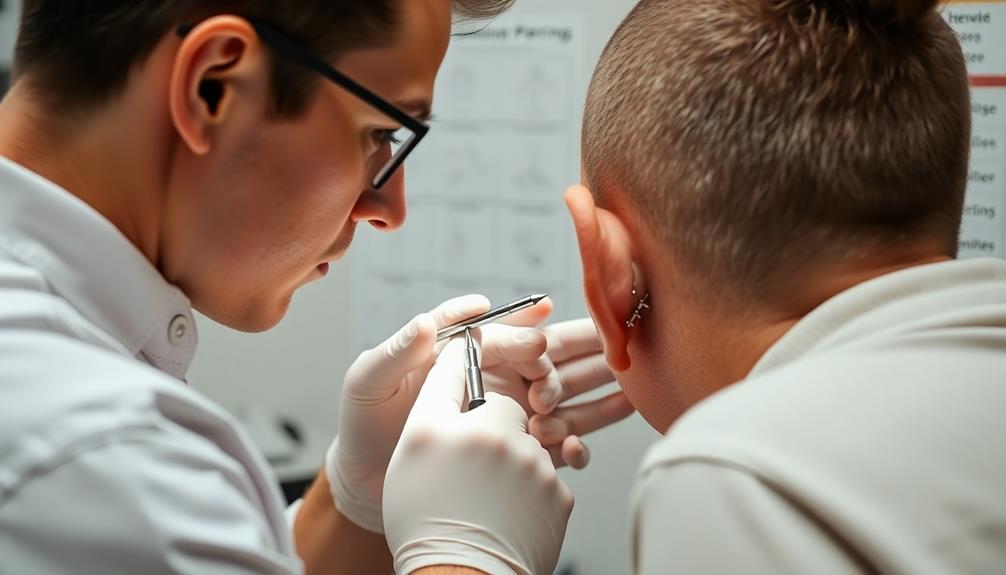
Regular professional evaluation is essential for anyone considering a piercing. This process helps you assess your individual anatomical features, guaranteeing the chosen location is suitable for the procedure and can support the jewelry.
Experienced piercers can identify potential complications arising from unique anatomy, such as blood vessel placement or tissue thickness, both of which impact healing and jewelry selection.
During your consultation, keep in mind these three key aspects:
- Anatomical Compatibility: A professional can evaluate your anatomy to guarantee that the piercing type you desire is safe and viable.
- Jewelry Selection: Based on your anatomy, piercers can recommend specific jewelry styles and materials that enhance comfort and reduce irritation or rejection.
- Personal Context: Bring items like glasses or earbuds to the consultation, as they provide context on how the piercing may impact your daily activities.
Frequently Asked Questions
What Does Anatomy Do With Piercings?
Anatomy affects piercings by determining where you can safely place them, how they'll heal, and what jewelry suits you best. Understanding your body's unique structure helps you avoid complications and guarantees a more comfortable experience.
How Does Ear Anatomy Affect Piercings?
So, you think any spot on your ear's fair game, huh? Well, your ear anatomy dictates piercing success. The shape, thickness, and position matter—ignore them, and you might end up with a painful, crooked disaster.
What Does Anatomy Dependent Mean for Piercings?
Anatomy-dependent means your unique physical features influence how a piercing functions and heals. Factors like tissue thickness and bone structure matter; they determine the best placement for jewelry and reduce the risk of complications.
What Piercings Do You Need the Right Anatomy For?
Did you know that nearly 30% of people experience complications with certain piercings? You need the right anatomy for navel, industrial, nipple, and surface piercings, as improper structures can lead to rejection or discomfort.
Conclusion
In the vibrant world of body art, understanding your anatomy is like having a map to treasure. Each curve and contour plays an essential role in achieving that perfect piercing. As you commence on this journey, remember to prioritize health and safety, respecting the cultural tapestry that surrounds piercing. Embrace the psychological transformation it brings, and always seek professional guidance. With knowledge and care, your piercing experience can shine like a jewel, celebrating your unique expression.
Hi, my name is Danielle, and I’m an author for piercings-body.com. I have a passion for writing and love to share my knowledge on all things body piercing-related. I’m also a huge advocate for safe body modification practices and believe everyone should be able to make informed decisions about their bodies. When I’m not writing or blogging, I enjoy spending time with my family and friends, practicing yoga, and exploring new places.
-
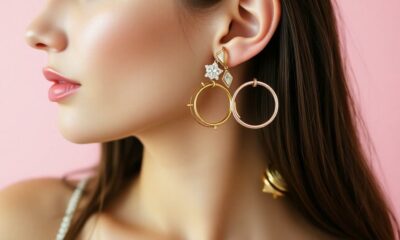
 Style and Fashion4 weeks ago
Style and Fashion4 weeks agoCreative Ways to Showcase Multiple Ear Piercings
-
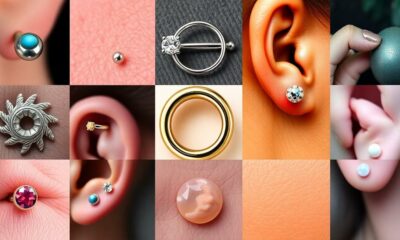
 Style and Fashion4 weeks ago
Style and Fashion4 weeks agoPiercing Jewelry Materials: Pros and Cons for Different Skin Types
-

 Style and Fashion4 weeks ago
Style and Fashion4 weeks agoHow to Coordinate Your Piercings With Your Personal Style
-
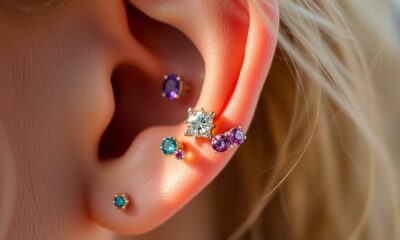
 Style and Fashion4 weeks ago
Style and Fashion4 weeks agoIncorporating Birthstones Into Your Piercing Jewelry
-

 Style and Fashion4 weeks ago
Style and Fashion4 weeks agoHow to Style Piercings for Formal Events and Weddings
-
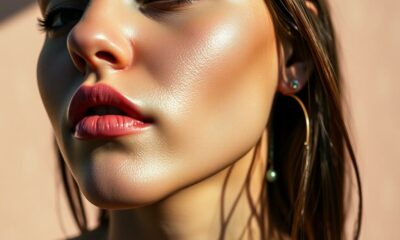
 Style and Fashion3 weeks ago
Style and Fashion3 weeks agoHow to Photograph Your Piercings for Social Media
-

 Style and Fashion4 weeks ago
Style and Fashion4 weeks agoThe Impact of Face Shape on Ideal Piercing Placements
-

 Style and Fashion3 weeks ago
Style and Fashion3 weeks agoMixing Piercing Styles: Bohemian, Minimalist, and Edgy Looks


